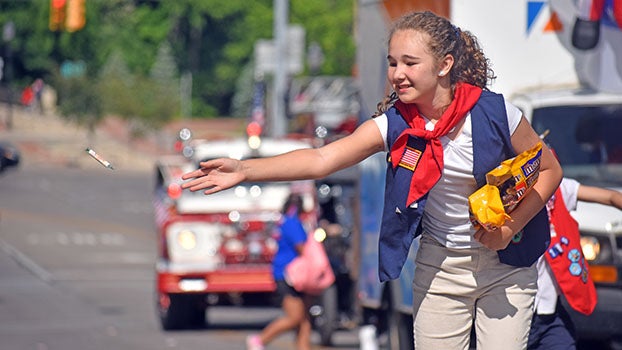Area man recalls life aboard WWII sub
Published 9:03 pm Friday, May 21, 2010

Shirley and Bob Eady of Niles recently celebrated their first wedding anniversary in Chicago, including watching the Cubs win last weekend. Bob retired in 1986 from Sundstrand in Dowagiac after about 25 years. (The Daily Star/John Eby)
By JOHN EBY
Niles Daily Star
The last ship Robert Eady’s World War II submarine the Sawfish sunk “was kind of classic in a way.”
“We had radar and the Japanese had none. They did have three submarines that had a special compartment built on the rear” to carry a seaplane.
“Our espionage found out the Japanese planned to send one of their subs to Germany and pick up radar equipment for their use. Well, when the U.S.A. got this input, the U.S. Navy commander put six of our subs together in a wolf pack between the Philippines and Formosa.
“This Japanese sub was supposed to pass through at noon on a certain day,” but wasn’t spotted until 4 p.m. – on the surface, just 100 miles from home.
“He came right at the Sawfish’s track,” Eady said, explaining that their skipper visualized the open sea as a bowling alley, with each sub assigned to defend a different “lane.”
“We fired four torpedoes at the target,” and with three hits, “there was no more Japanese sub,” said Eady, who has a book describing that it was “immeasurable how much that shortened the war.”
“It was devastating, but very effective,” he said. “When you take three torpedoes, there are no people” to capture as prisoners.
The sinking was in July 1945.
In August atomic bombs fell on Japan, ending World War II.
Eady, the 10th most senior member of Dowagiac Rotary Club, was drafted into the Navy at 21 in Detroit in February 1942 and served until November 1945.
Training at Great Lakes was “very physical in heavy shoes, a bit of a bear.” KP (kitchen patrol). A case of measles.
And a typing instructor who graded an E for one error on a test.
“I had 50 words per minute, no errors,” so Eady advanced to Yeoman 3rd Class and was one of five from a class of seven assigned to a final training class in New London, Conn.
During that round of training he had three psychological tests.
Why he chose sub service; then what his family thought; and finally, was he serious?
“The Navy was very thorough in teaching you,” he told his fellow Rotarians Thursday noon at Elks Lodge 889.
Eady, who was 5-foot-10, passed a test to see if his ears could withstand undersea pressure.
“Some men would stay in the chamber until their ears bled, then they would be let out and assigned to other military duty,” Eady said.
On Jan. 1, 1943, he arrived in San Francisco, where he was assigned to the Sawfish for active duty.
His seven-compartment submarine carried 72 men – 10 officers and 62 sailors – and 24 torpedoes, six forward and four aft.
Eady was expected to complete five “patrols” of five to seven weeks in duration without seeing the sun.
“When you got rid of the torpedoes, you had to go back to the base,” he explained. “You’d come in for a week or two leave. The first time we came in, as we got off the sub and walked up to the shore, the only thing on the island was the officers quarters, where I wasn’t allowed, and goony birds, which were kind of screwy. They were on the lawn of the officers quarters. They decided to take off. They were chopping along and there was a wire fence the goony birds never saw. They tripped themselves. We got the chance to play baseball against another submarine. Tennis. Just rest and recuperation, then go on to the next patrol.”
Eady maintained the ship’s log.
After the five patrols, they went to Hawaii.
“Our log was turned over to the highest officer in the Pacific. They shared that log with the other ship captains to see what the Japanese were doing,” he said. “It was pretty valuable in understanding the warfare of the Pacific.”
Asked about the captured German submarine displayed at the Museum of Science and Industry in Chicago by Herb Phillipson, Eady said it and the Sawfish were both diesel-powered.
“We had four diesel engines on the Sawfish,” he said. “In ’86, when I retired, my family and I went through the German sub. It still smelled of oil. I’d never been in a plane. Train, yes. But our travel at that time in the ’40s was very minimal compared to today.”
Off Tokyo Bay, “where we waited for some ships to come out and sail to wherever their troops were that needed supplies,” in about a week a Japanese ship “poked his head out of the ocean and we let him have a four-torpedo spread. Down he went.”
“There was a rule,” Eady said, “that our subs couldn’t count a sinking unless we saw it in our periscope. We claimed five, and the latest count I have seen was 10.
“Besides the sinking of ships, we picked up two of our fliers who had been shot down. The first one was near Formosa, north of the Philippines, and had landed in a mine field. We had to wait three days until he floated out to open water. He had no water or food for three days and the weather was hot. He was rather delirious.
“We finally convinced him that we were friends,” Eady recalled, “and he tossed his gun away. We continued our patrol and sunk a ship or two. He was scared skinny and one of us had to keep him company to make him easy.
“The other flier we picked up didn’t miss a meal. “






